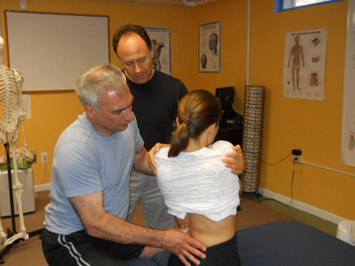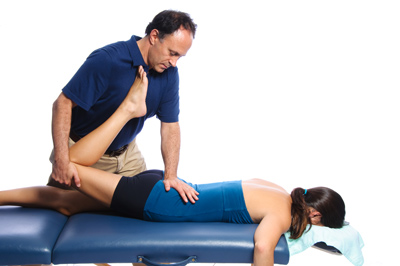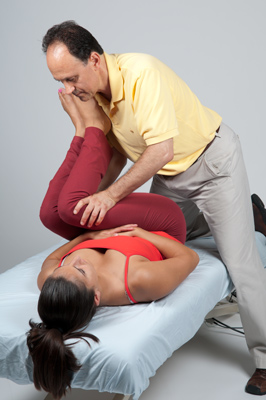 COURSE DESCRIPTION
COURSE DESCRIPTION
Clinical Orthopedic Manual Therapy (COMT) for the Low Back and Pelvis covers the major clinical orthopedic assessment and treatment techniques for the lumbosacral region. This course is a 2-day hands-on workshop.
Day one begins with orthopedic assessment for the common neuromusculoskeletal conditions of the sacroiliac joint and lumbar spine. We then cover body mechanics for deep pressure for working the lower back in prone and side-lying positions. With proper body mechanics, you will learn how the low back can be worked deeply with little effort. We also learn how to palpate and safely and effectively work the psoas major, both abdominal and femoral bellies, in multiple positions. We then discuss fundamental concepts of stretching, beginning with basic stretching for the functional muscle groups of the lower back and then learning how to target each specific muscle with multiplane stretching.
Day two covers more advanced stretching. We begin with advanced neural inhibition stretching techniques, including Contract Relax (PNF/PIR), Agonist Contract (the basis for AIS), and Contract Relax Agonist Contract stretching techniques. We also cover pin and stretch technique. Day two concludes with Arthrofascial Stretching (AFS): Soft Tissue Joint Mobilization for Manual Therapists (including traction) for the lumbosacral spine. AFS is the only effective means of stretching the intrinsic fascia of specific hypomobilities of the lumbosacral spine.
Clinical treatment strategy as well as precautions and contraindications are also covered. These manual therapy skills will empower you to do effective clinical orthopedic work. Throughout this hands-on workshop, Dr. Joe Muscolino reinforces the underlying mechanisms for each of the assessment and treatment techniques, encouraging critical reasoning skills.
Clinical Orthopedic Manual Therapy for the Low Back / Pelvis is part of the COMT Regional Approach Certification. The other hands-on workshops in this series cover the neck, thoracic spine / ribcage, upper extremity, and lower extremity.
COURSE OBJECTIVES
 After attending this workshop, the participant will be able to:
After attending this workshop, the participant will be able to:
Explain and demonstrate the principles of using core body weight and larger muscle groups for efficient body mechanics when performing soft tissue manipulation, stretching, and Arthrofascial Stretching (AFS) – Soft Tissue Joint Mobilization.
Perform orthopedic assessment tests for the low back and pelvis to determine the ability to safely perform deep pressure massage, stretching, and joint mobilization.
Describe and be able to access and work the muscles of the low back and pelvis, including the psoas major muscle.
Explain the fundamental concepts of stretching and apply these concepts to the musculature of the low back, pelvis, and hip joint.
Demonstrate how to stretch each of the functional muscle groups of the low back and hip joint.
Explain and demonstrate how to stretch each of the muscles of the low back and pelvis in all three cardinal planes.
Explain the physiologic basis for and demonstrate how to perform contract relax (CR; also known as PIR/PNF) stretching, agonist contract (AC) stretching, and contract relax agonist contract (CRAC) stretching techniques.
Explain the physiologic basis for and demonstrate how to perform Arthrofascial Stretching (AFS, Grade IV joint mobilization) of the sacroiliac joint and lumbar spine.
DETAILED TIME LINE
Following is the usual time line for this workshop. Note: This time line is often adjusted as needed based on the needs of the particular group.
DAY ONE
Introductions: 15 min
- Introduction to the content of the class
- Introduction of instructor and workshop participants to each other
Assessment (lumbar and sacroiliac joint): 90 min
- Discuss concept of space-occupying conditions (pathologic disc and bone spurs compressing nerves)
- Straight leg raise (active and passive)
- Cough test
- Valsalva maneuver
- Slump test
- Nachlas test
- Yeoman’s test
 Body mechanics and prone work: 60 min
Body mechanics and prone work: 60 min
- Table must be low
- Orient core in line with stroke
- Keep elbow in
- Stack joints
- Sagittal plane stance
- Work perpendicular to contour of client’s/patient’s body
- Lean in with body weight / core
- Brace contact (thumb pad, finger pads, palm, ulnar side of hand, fist elbow, forearm)
Break: 15 min
Body mechanics & prone work: 60 min
- Continue workshopping prone body work as above
Lunch: 60 min
Palpation of the low back and gluteal muscles: 90 min
- Discuss concept of palpation
- Palpate erector spinae, quadratus lumborum, piriformis, psoas major (supine and ¾ side-lying – abdominal and femoral bellies)
Basic stretching (concept and body mechanics): 30 min
- Stretching is a mechanical protocol for making a soft tissue longer
- For a muscle, it involves passively bringing the patient’s low back or pelvis into a position that is the opposite of its action(s)
- Concept of stabilization: how to figure out how to stabilize the client’s/patient’s trunk or pelvis
- Introduce concept of functional groups of muscles (extensors, flexors, right lateral flexors, left lateral flexors, right rotators, left rotators)
- Incorporate body mechanics with elbow joint in, stacked joints, and using the core
- Begin with functional groups and narrow the scope to be able to target a specific muscle within the functional group (multiplane stretching)
- Consider all planes of motion (i.e., all joint actions) must be considered to optimally stretch a muscle: example: right versus left sided erector spinae and transversospinalis groups
Break: 15 min
Stretching the low back (and hip): 90 min
- Workshop all six functional groups
- Workshop specific muscles/muscle groups: gluteal muscles, erector spinae, quadratus lumborum, anterior abdominal wall, psoas major (supine side of table, supine end of table, prone)
Review: 15 min
- Question and answer
- Discuss treatment strategy
DAY TWO
Review of day one: 15 min
- Question and answer over material from Day 1
Contract Relax (CR) stretching: 60 min
- Principle of Golgi tendon organ reflex
- Demonstrate CR protocol for lateral flexor group
- Workshop CR technique for each of the major functional groups
- Workshop CR for specific target muscles
Break: 15 min
Agonist Contract (AC) stretching: 60 min
- Principle of reciprocal inhibition reflex
- Demonstrate AC protocol for lateral flexor group
- Workshop AC technique for each of the major functional groups
- Workshop AC for specific target muscles
Break: 15 min
CRAC stretching: 60 min
- Demonstrate CRAC protocol for low back extensor functional group
- Workshop CRAC for specific target muscles
- Discuss integration of treatment techniques
Overview of Arthrofascial Stretching (AFS, Grade IV joint mobilization): 30 min
Lunch: 60 min
AFS of the SIJ – prone: 90 min
- PSIS compression (anterior, anterior and superior, anterior and lateral, anterior, superior, and lateral)
- Sacrum compression midline and lateral
- Sacrum apex mobilization with pillow support under lumbar spine
AFS of the lumbar spine seated: 60 min
- Steps: 1) Place pin. 2) Bring joint to tension. 3) Mobilize.
- Hold for less than a second, 3-5 oscillations
- Soft tissue pull to trap underlying bone
- Contraindications…
- Use hands in concert
- Utilize body mechanics
- Workshop lateral flexion, rotation, extension
Break: 15 min
Traction: 60 min
- Towel traction
- Sagittal plane stance
- Add in lateral flexion and/or rotation components (change to frontal plane stance)
- Manual traction
Review and paperwork: 15 min
- Question and answer
- Fill out evaluation forms
- Hand out Certificates
WORKSHOP PARTICIPANTS SHOULD BRING
1. Massage table with face cradle
2. Stool
3. Bolster and pillow
4. Sheets and face cradle cover
5. King-sized pillow case, preferably flannel (or thin/threadbare bath-sized towel)
6. Gym shorts (loose fitting, not spandex)
7. Water-based lotion
8. Soft foam cushion (approx. 6×10 inches) or bath towel
Copyright 2014 © The Art and Science of Kinesiology – Dr. Joseph E. Muscolino
